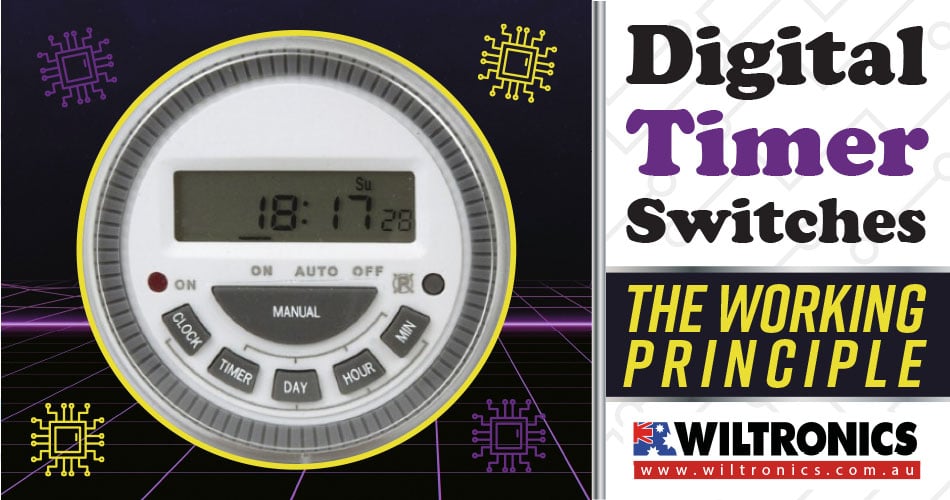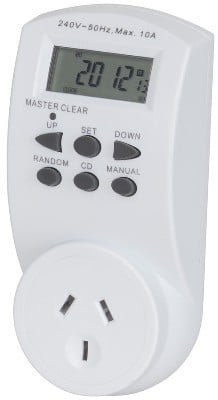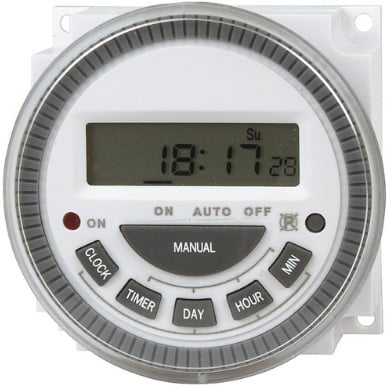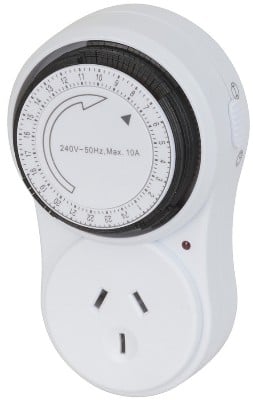Digital Timer Switches Explained: The Working Principle
June 17, 2022

Digital timer switches will lower your energy costs and help you save money over time.
We use electronic devices—electricity, in general—for practically everything. With the increase in energy rates and shortages, energy conservation is crucial.
Another concern is keeping track of whether all these devices are on or off. And if you always end the month with high utility bills, it is time to find a way to cut back on your electrical use.
One way is to limit the wastage in your power supplies. This is where power automation & timers, such as time switches, come into play.
You can find two types: analogue and digital. In this post, we will focus on the working principle of digital timer switches.
Time Switch Explained
A time switch has several applications in everyday life. It is a device that controls exactly when an appliance or a lighting system is to be switched on or off.
Designed to cut off small but recurring energy wastage before it gets out of hand. Also called a timer control, it can also be used with various household applications.
With ease of use and installation, the switch will control your appliances. Thus ensuring they are only turned on when you need them to be.
Time switches can make your home smarter. You can also link the switch to your home security system.
There are two ways to enhance how and when energy is used by the switch, and these are:
- Create a fixed schedule. Activate the time switch every day between certain set hours.
- Set a limited interval. Set for a specific number of minutes or hours after being switched on.
Time switches can be programmed daily, weekly, and yearly. Moreover, they are suitable for installation in residential and commercial buildings.
As mentioned, there are two types of time switches: analogue and digital. To start, an analogue or mechanical switch features a spring that tracks time.
Its ease of use allows setting a specific time as easy as you would with a watch.
Unlike its digital counterpart, it operates manually and is relatively inexpensive. It is a perfect investment if you are looking for a reasonably priced time switch.
Now, for the digital version.
What Are Digital Timer Switches?
Digital timer switches operate according to a program. In contrast to analogue, this type of switch provides a 24-hour control.
Some models even allow you to set different settings for different week days. Since they are programmable, digital types are suitable for many occasions.
Suppose you are not at home. You can set a seven-day timer if you are out of town for a week. Some modern units also let you protect your switch with a password so no one can control the settings other than you.
As technology improves, digital timer switches can now also come with sensors. Or be compatible with smartphones and smart home systems like Google Home.
Control your smart home using your smartphone as a remote. Or through voice control via Alexa.
How do digital timer switches work?
They are typically connected to electrical circuits powered via the main supply. Digital timer switches feature timing circuitry, switching devices, and no moving parts.
Such switches can be used to turn lights on or off at times selected by the user. Some models allow for the pre-setting and cyclical arrangement of lighting levels.
The advantages and disadvantages
Advantages of installing a digital timer switch include:
- The digital timer switch provides a variety of options.
- Digital timer switches can come with sensors detecting the amount of light required. This feature also helps save power.
- The design is visually attractive and makes them look modern.
- Ideal for multifunctional use as it provides many services under a one-time switch.
Disadvantages of installing a digital timer switch include:
- The wiring required to set the timer is different from standard wiring. It needs a neutral wire, which is different from a ground wire. Using a ground wire, meanwhile, may cause danger.
- Digital timer switches also need different switchboards. Before installing, you must plan in advance. Otherwise, they will may not be matched with ordinary switchboards at home.
If you have neutral wires and the needed switchboards, then there is nothing to worry about. Considering all the pros, a digital timer switch is surely a worthwhile investment.
Moreover, they can be automatically controlled and set by a specific date and time. Either put it seven days a week, 24 hours a day or even once a year.
The ease of use and convenience is a big plus!
Applications
Digital timer switches have both common consumer uses and large industrial uses. Timers are used in process control equipment to assist in process regulation.
They are installed in industrial equipment to record their use and age. And they are used as consumer electronics for household and recreational use.
They are ideal for tasks such as:
- Timing lights to turn on/off in aquariums
- Switching off Christmas lights
- To turn on/off heaters
- In general, switching on/off electronic devices at times when they are/aren’t needed
Get Your Digital Timer Switches Here!
Use power automation and timers to schedule when to provide power with our digital timer switches.
Also available are remote controlled mains switches. These are great solutions for hard to reach powerpoints.

1. Digital Mains Timer Switch 10A 240V with LCD Display
Product code: JMS6114
This switch is more advanced than a mechanical timer, featuring 6 operating buttons. You can set it for the time of day and also the day of the week.
The integrated LCD shows the current status and guides you through setup. It also comes with an override on/off/auto selection.
Its high accuracy and strong anti-interference allow you to save electricity and money. Most importantly, to help to protect the life of your equipment.
Suitable for household appliances, phone chargers, heaters and air conditioners, and more.

2. Digital Timer Switch Module 12V/16A@240VAC
Product code: JAA0361
Ideal for automating switching applications that require multiple unattended switching cycles. A great example of this is your heating and lighting home systems.
The switch features eight on/off settings configured to work on any day or a combination of days in the week. Each of the on/off settings can be set independently.
Moreover, it can correlate with a number of days ranging from a single day to every day. This gives a total of 56 possible on/off cycles per week. The configuration procedure is simple and straightforward.
3. Remote Controlled Mains Switch – 3 Outlet Mains Controller
No longer available
Product code: JMS6147
Turn any standard mains outlet on and off with this remote-controlled mains switch. A 3 outlet mains controller is great for switching off hard-to-reach power points.
The remote has a range of up to 30m. Individual control of three mains outlets.
You might also like...

24 Hour Mechanical Timer Switch (A-N Switch)
Product code: JMS6113
This high-quality mechanical switch is ideal for controlling the time appliances are powered. Effective for automatically switching your devices on and off at particular times.
Setup takes mere seconds, then set and forget, and it works in 15 min increments. This unit also includes an override switch to engage power when required instantly.
The Bottom Line
Owning a time switch means you can control your household electricity more efficiently. The programmed switching on/off of loads provides energy savings.
This is more economical than loads that would be on all the time. Digital timer switches, overall, are a good choice and a great asset.
With one, you can operate your appliances and security system with convenience. While at the same time, making your home safer and more secure.
© Electrotech Brands Pty Ltd 2022


Write a Comment
You must be logged in to post a comment.